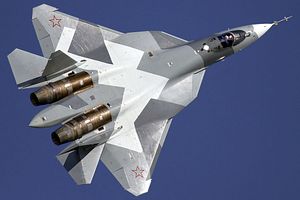This week, the head of Russia’s United Aircraft Corporation (UAC) announced that a full R&D collaboration contract would be signed in 2015 with New Delhi for joint work on the derivative Indian version of the PAK FA T-50 fifth-generation fighter jet, the Perspective Multi-role Fighter (PMF).
The contract could be signed as early as July, as a follow-up to Indian Prime Minister’s Narendra Modi’s visit to Russia. Defense News reports that according to an unnamed source within the Indian Ministry of Defense (MOD), India is compromising on various points of conflict over the joint R&D program.
Most interestingly, the draft agreement will include a fixed order of 154 PMFs, and include a compromise on work share, a firm commitment to the number of single- versus double-seat PMF (aka Fifth Generation Fighter Aircraft) jets, and steps that specifically address each of the approximate 40 changes that the Indian Air Force (IAF) wants in comparison to the current T-50 prototype.
In my piece yesterday (see: “Russia to Receive New Fifth-Generation Fighter by 2017”), I quoted IHS Jane’s Defense Weekly summary of additional past concerns, which apparently are also being slowly resolved by now:
Enduring Indian reservations over the FGFA program include those over the fighter’s AL-41F1 engine and its stealth and weapon-carrying capability. India is also insistent on Russia restoring its workload in the USD10.5 billion developmental program after recently reducing it from 25 percent to 13 percent without consulting Delhi.
Additionally, concerns according to Padamjit Singh Ahluwalia, a retired Indian air marshal, include:
IAF questions the indigenous development aspect in this skewed ratio. The AL-41 engine, which is supposed to power the FGFA, is not yet developed. AL-31, which powers the Su-30 MK, is not capable of supersonic cruise. Avionics, including active electronically scanned array radar, do not have any visibility
As I reported a while back (see: “What’s the Status of the Indian-Russian Fifth Generation Fighter Jet?”), New Delhi and Moscow agreed in early 2007 to jointly develop a fifth generation fighter program. Ever since then, the Sukhol/HAL Fifth Generation Fighter Aircraft (FGFA), or, as it is called in India, the Perspective Multi-role Fighter (PMF) project, a derivative project from the PAK FA T-50, has been plagued by delays, cost overruns, and unsteady technology.
However, despite delays, the program will in all likelihood not get cancelled, according to Kapil Kak, a retired Indian Air Force air vice marshal and defense analyst quoted by Defense News:
At this juncture, given the unfolding international geopolitics and Russia’s fast-depleting defense export order books, it is highly unlikely that Russia would take a take-it-or-leave-it stand. FGFA is a landmark, collaborative, futuristic defense project that would doubtless benefit both countries.
Russia required FGFA for its industry to stay competitive with the Western systems, reduce development cost and guarantee an export customer; India saw it as a means to address the IAF–People’s Liberation Army Air Force imbalance and impart a measure of resonance to its combat aircraft development programs.
Padamjit Singh Ahluwalia provides another perspective on the projected delays and what options the Indian Air Force (IAF) has:
Considering the anticipated delay in the project and to avoid any shortfalls in the IAF force levels, the options include: develop the indigenous AMCA; LCA MK II development would be indicative of capability; consider increased procurement of Rafale or F-35; propose to purchase 18 T-50s off the shelf and subsequently assess the probability of success of the FGFA.
































